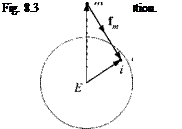Gravitational Attraction
What is gravity? Nobody knows for sure; we only can measure its effects. Long ago the ancient Greeks wrote about it and speculated about its origin. For us engineers, Isaac Newton has provided all we have to know. His inverse square law says it succinctly: The gravitational pull between two bodies is proportional to the product of their masses and inversely proportional to the square of their distance. Suppose two particles with mass да and да,- are separated by r, then the force of attraction F is, with G as the proportionality constant,
![]() (8.15)
(8.15)
If the body consists of a collection of particles да, , г = 1, 2, 3, …, then the test mass m is affected by the attraction of each particle. As we place the test mass at different locations, we can calculate the gravitational field by measuring the force and dividing it by the test mass да. Introduce the displacement vectors s TE of the test mass T wrt a reference point E of the massive body E, and the displacement vector SiE of a particle і wrt the same reference point E (see Fig. 8.3). The gravitational field is described by
![]()
 |
(8.16)
where the force vector of the test mass fm has the same direction as the displacement vector s, T = SiE — sTe■ The gravitational field is the gradient of the gravitational potential S7U{ste] = gf-S’/r}- The gravitational potential itself defines the equipotential surfaces
A unit test mass has the same potential energy anywhere on an equipotential surface against the collection of particles m,-, і = 1, 2, 3,… .
The equipotential surface of the Earth is called the geoid, an irregularly shaped envelope. An important approximation of the geoid is the geocentric equipotential ellipsoid of revolution. Its most recently updated dimensions are given in the Defense Mapping Agency’s “U. S. World Geodetic System 1984 (WGS84)”.5 I have more to say about it in Chapter 10, when we derive the equations of motion for an elliptical Earth.
In this chapter we confine ourselves to the approximation of a spherical Earth, defined by a gravitational field with spherical equipotential surfaces. Its gravitational field simplifies after having summed Eq. (8.16) over the homogenous sphere
Suppose the test mass is a missile T with mass m. The gravitational acceleration on the missiles is in the opposite direction of the displacement vector. v EE of the missile wrt the center of Earth E, and the magnitude of the gravitational force is with |®ге| = r
![]() (8.17)
(8.17)
The product GM is an important constant for planet Earth with the value GM = 3.986005 x 1014 m3/s2.
Living on Earth subjects us to a gravitational acceleration of g = 9.82023 m/s2. Yet we do not feel the full brunt of Earth’s pull because it is opposed by the centrifugal force of our “merry-go-round.” Both accelerations vectorially added results in the so-called gravity acceleration
![]() Ей{5те) =g~ nE, nE, sTE = —GM r—- Ue, Ueiste
Ей{5те) =g~ nE, nE, sTE = —GM r—- Ue, Ueiste
with Earth’s angular rate of coEJ = 7.292115 x H)~5 rad/s. The value of the gravity acceleration depends on your latitude and altitude. At sea level (mean radius of Earth — 6,371,005 m) standing on the equator, gg = 9.7864 m/s2, and at 45° latitude gg = 9.8033 m/s2. The accepted standard average value Ls g — 9.8066 m/s2. Come, join me at the equator, life is lighter there! Before you leave however, make sure you understand the difference between gravitational and gravity acceleration.











